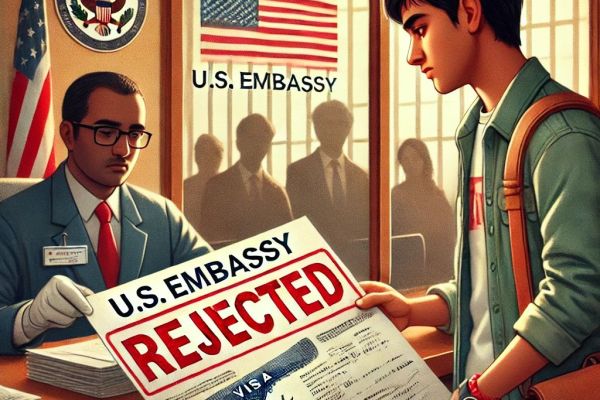Deciphering the U.S. Student Visa Process: Crucial Insights & Strategies for Indian Applicants Amidst Escalating Rejections
USA Visa Refusals

Navigating the U.S. Student Visa Process: Insights & Tips for Indian Students Amidst Rising Rejections
A Surge in U.S. Student Visa Rejections: Understanding the Trends
In recent years, the United States has remained a top destination for Indian students pursuing higher education. However, an increasing number of student visa rejections have raised concerns, particularly in the Spring 2025 intake. Notably, students from Telangana and Andhra Pradesh, which send the highest number of students to the U.S., have faced rejection rates exceeding 50%. However, this trend is not limited to these states—students from Gujarat, Maharashtra, Mumbai, and Punjab are also experiencing similar challenges.
A report from the U.S. Department of Homeland Security highlighted that 6.79 lakh F-1 visa applications were filed in the 2023-24 academic year, of which 2.79 lakh (41%) were rejected. A significant portion of these denials came from Indian students, marking the highest rejection rate in two decades. Even students admitted to Ivy League institutions were not exempt, raising questions about the factors contributing to this trend.
Key Factors Behind the High Rejection Rates
While U.S. visa officials do not always provide explicit reasons for rejection, a detailed analysis of cases suggests that multiple factors are at play:
-
Minor Discrepancies in Application Details: Errors in personal information, inconsistencies in academic history, or incomplete supporting documents can lead to rejection. In the past, minor mistakes were often overlooked, but in the current climate, even the smallest discrepancies can be detrimental.
-
Concerns Over Visa Overstays: In 2023, over 7,000 Indian students overstayed their visas, leading to stricter scrutiny of applicants. The U.S. is now taking proactive measures to identify potential overstayers, making it crucial for students to convincingly demonstrate their intent to return to India post-graduation.
-
Lack of a Clear Academic and Career Path: Visa officers assess whether a student’s chosen program aligns with their previous education and career goals. A lack of clarity or inconsistency in these aspects raises red flags.
-
General Nervousness and Overconfidence: Many students struggle to confidently answer questions in the visa interview, while others come across as overconfident. Both extremes can be detrimental—students must strike a balance between preparedness and authenticity.
How Students Can Improve Their Chances of Securing a U.S. Student Visa
To navigate the challenging visa process effectively, students must take proactive measures in preparing their application and interview responses. Here are some key recommendations:
1. Fill Out the DS-160 Form With Utmost Accuracy
The DS-160 form is a critical component of the visa process. Every detail must be accurate and match supporting documents. Any inconsistencies can lead to rejection.
2. Present a Strong Academic Purpose
Students must be able to clearly explain:
-
Why they have chosen their specific course.
-
How it aligns with their previous education and future career goals.
-
Why the U.S. is the ideal destination for their studies.
Visa officers look for a logical and well-thought-out academic trajectory.
3. Have a Realistic and Well-Defined Post-Graduation Plan
Students must convincingly explain their plans after graduation, including how their U.S. degree will benefit them in India. This reduces concerns about potential overstays.
4. Dress Professionally and Approach the Interview Confidently
The visa interview is a formal process, and students must dress appropriately, as they would for any professional interview. They should maintain eye contact, answer questions concisely, and avoid appearing nervous or overconfident.
5. Be Thoroughly Prepared for Common Visa Interview Questions
Practicing answers to frequently asked questions can help students build confidence. Some common questions include:
-
Why do you want to study in the U.S.?
-
Why did you choose this university and program?
-
What are your career goals after graduation?
-
How will you finance your education?
-
Do you plan to return to India after completing your studies?
6. Avoid Overconfidence and Superstitions
While preparation is key, students must also avoid being overconfident or relying on myths and superstitions. Some applicants believe that choosing a specific time slot, wearing a certain color, or answering in a particular way will improve their chances. The reality is that a well-prepared and honest applicant is more likely to secure a visa than someone relying on luck.
Conclusion
The recent spike in U.S. student visa rejections has made it essential for Indian students to be more meticulous in their application and interview preparation. While the situation may seem daunting, the right approach—accurate documentation, clear academic and career objectives, and strong interview performance—can significantly improve the chances of approval.
Students should remain hopeful and proactive in their approach, focusing on genuine and well-structured applications. The U.S. remains a premier education destination, and with the right strategy, aspiring students can still achieve their dreams of studying abroad.
This article is published by Team Student Central for informative purposes.
Posted 3 weeks ago